Sooner or later, it happens. Your warp gets tangled, you make a bunch of mistakes while threading, or you find a treadling error – after you’ve woven four more inches. Or your project colors don’t turn out as expected.
What do you do when your project has you ready to pull your hair out?
This happens to everyone – including me! – so I thought I’d share my experience with some epic frustrations, and offer some strategies that you might find helpful.
The project
I started my project Autumn Splendor with a vision of a coat with an asymmetric collar, in smooth color gradients. Here’s the original sketch:
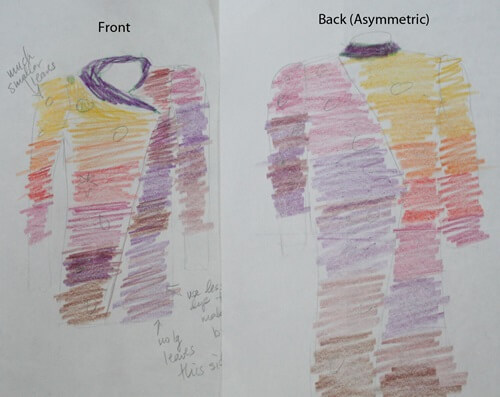
I loved the nice smooth color gradient in this mockup:
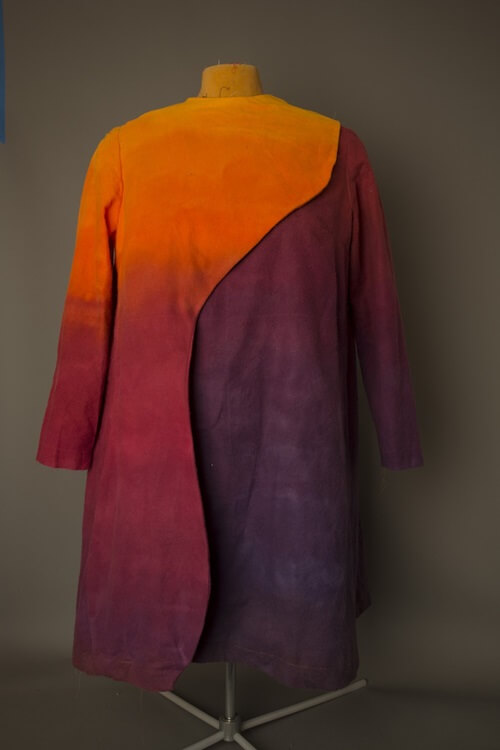
Because I already had a white warp on the loom, I decided to do the color gradients in the weft. To test this idea, I machine knitted a rectangular piece of fabric, using the weft yarn, then dyed it in a color gradient. The result was beautiful – gentle color transitions with a bit of visual texture.
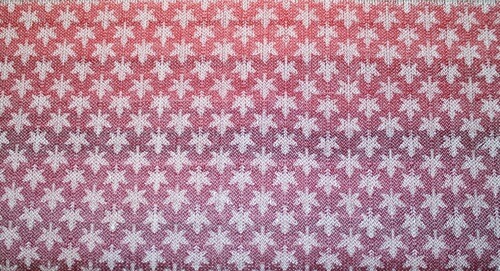
Happy with the sample, I knitted up some VERY long rectangles and carefully painted them with dye. Then I rolled up the knitted blanks like a jelly roll, and set the dyes by heating them (carefully!) in the microwave oven.
Horrors!! I had forgotten that dyes are liquids. The dyes pooled at the bottom of my rolled-up rectangles, so the bottoms of the rolls dyed much darker than the top.
As soon as I started weaving, I saw that my dye mistake was producing darker stripes in my nice smooth color gradation, like this:
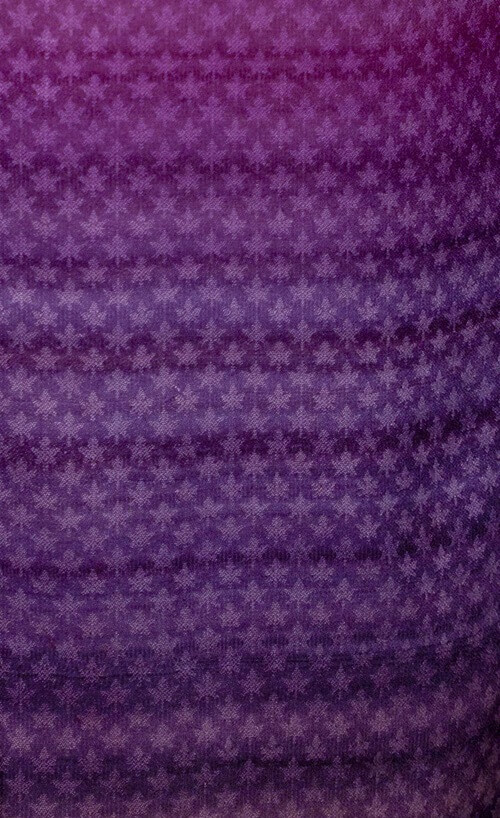
Having just spent hours and hours knitting and dyeing enough yarn for 16 yards(!) of fabric, I couldn’t believe my screw-up. I was ready to swear at anything and everything – both the project and myself.
So I did the only sensible thing – I gave us both a time-out.
Strategy #1: Walk away for a couple of days.
When you’re too close to a problem, it’s hard to see solutions. That’s particularly true if you’re frustrated – anger can easily cloud your thinking. So often the first step in solving frustration is to give you (and the project) some space.
After a couple days, I came back to the fabric and re-examined it with fresh eyes.
And hey – it didn’t look bad at all!
The fabric wasn’t terrible, it just wasn’t what I originally envisioned.
In fact, looking at it, I thought it was much more interesting than the smooth gradient I’d been imagining.
Strategy #2: Let go of your expectations
Often we get frustrated because a project isn’t turning out as expected. But what we see as a flaw may actually be an opportunity, or an improvement. In order to see that, you need to let go of your expectations and see the project as it is, not as you wanted it to be.
This is easier if you’ve put the project in a time-out first.
After deciding that I liked the fabric after all, I got back to work. I was not only designing the fabric, but the coat pattern, too.
Soon I ran across a road block. I had originally designed the piece to have a dramatic, asymmetric collar, because I liked the idea. As I went along, the collar got more and more dramatic, as in the photo below.
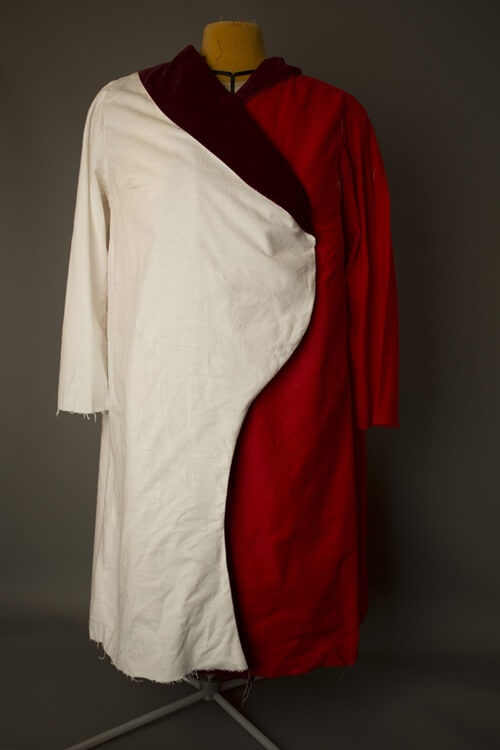
But I couldn’t get the idea to work, no matter how hard I tried. The straight line created by the fold of the collar felt awkward. I sewed not one, not two, but nine mockups, trying to get the idea to work. I can’t tell you how many hours I invested into getting that collar right.
After cursing for a couple of weeks, I asked my blog readers for suggestions. I immediately got an outpouring of support, and a bunch of ideas.
Strategy #3: Ask for help
When you’re frustrated, ask others for their thoughts and perspectives. This is helpful, both for emotional support (more important than you might think!) and for practical suggestions. It’s easy to get too close to your work, and an outside perspective can help you reframe your thoughts and offer alternatives you hadn’t seen.
The most intriguing idea came from a reader who said, simply, “Do you need the collar?”
What?? Of course I needed the collar! It was the centerpiece of the design, the one I’d spent countless hours on already. No way…
Wait. Did I need the collar?
But what about all the time I’d invested in it?
Strategy #4: Ignore sunk costs
(for more info on Seth, check out his blog)
When you’ve sunk a lot of time or money into a project already, that investment can easily cloud your thinking. “But I’ve put 20 hours into this project already!” This can lead you to waste even more time and energy on a project that isn’t working, or that will cost more to finish than it would to start over. Seth Godin offers this way to look at sunk costs: The thing you’re considering (a project, a law degree, a car) is a gift from your past self to the you of today. Do you want to accept that gift, or is it time to thank Past Self politely, and decline?”
My blog reader had helped me realize that the collar, my original centerpiece, wasn’t necessary. I thanked Past Self for the gift, and moved on.
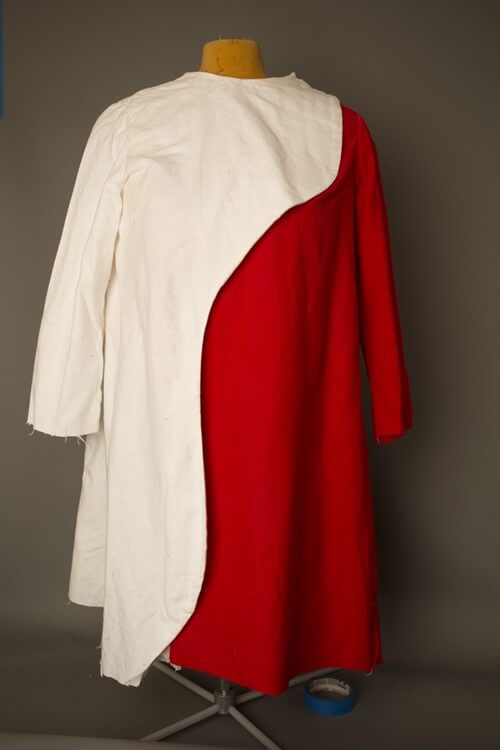
Towards the end of the project, I ran across a final problem. I wanted to paint some leaves onto the nearly-finished coat, but despite practicing on lots of scraps of fabric, I just couldn’t seem to get it right. And if I messed up, I’d have ruined the project that I’d spent several hundred hours on already. Talk about pressure!
I finally decided that I needed to do something completely different. But what?
Strategy #5: Brainstorm alternatives
One of the best ways to get past a frustrating problem is to brainstorm alternatives. Sitting down with pencil and paper and brainstorming longhand can be extremely effective. (For some reason, I’ve found that writing this out by hand, rather than typing, is more effective. Possibly because it uses a different section of the brain, or possibly because writing with a pencil is slower, so gives more time to gather your thoughts. It’s worth a try!)
I spent about ten minutes writing down ideas. Eliminating the leaves, replacing them with a brooch, weaving leaves out of wire, painting them onto leaf-shaped pieces of fabric – plus about fifteen other ideas. I tried to get some wild ideas, too, because you can’t find good ideas without generating a lot of bad ideas. It’s just how things work.
Eventually I decided that it would be fun – and much less risky – to cut leaf shapes out of fabric, and to layer a sheer fabric with a stiffer fabric to make the leaves more three-dimensional.
And that’s what I did!

Before I leave you, I’d like to mention one other strategy, perhaps the most important one:
Strategy #6: Don’t kick yourself!
When we’re frustrated, particularly when we’ve just made “obvious” mistakes, it’s tempting to kick ourselves. But don’t do it! Blaming yourself just makes things worse. Instead, look at your mistake as a “learning opportunity” – and most of the time, it is, because figuring out how to fix things is a form of learning.Instead, remind yourself that everyone makes mistakes, and everyone gets frustrated from time to time. It’s normal, and it doesn’t mean there’s anything wrong with you.
Oh, and the finished project? Despite all the mistakes, setbacks, and frustration, I LOVED the end result!
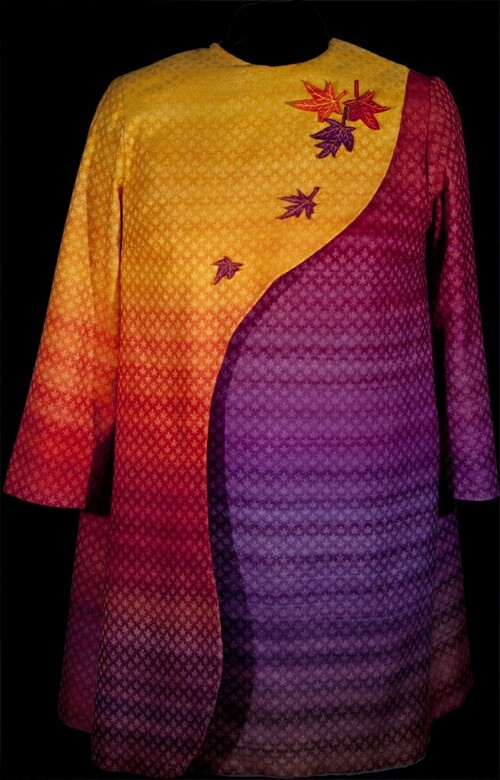
So when you get frustrated, remember that you’re not alone! It happens to everyone. And you may find that you love your finished project all the more!

